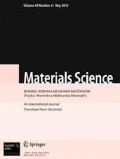We propose a new theory of bending of thick plates in the case where its stressed state is not described by the Kirchhoff–Love or Timoshenko hypotheses. It is assumed that the three-dimensional stress-strain state of the plate can be split into symmetric bending and symmetric compression. To describe symmetric bending, we use three harmonic functions. Integrating over the thickness of the plate, we express the bending and torsional moments and shear forces via two two-dimensional functions. The relations of the three-dimensional theory of elasticity are satisfied and a closed system of sixth-order partial differential equations for the introduced functions is constructed without using any hypotheses about the geometric character of deformation of the plate. The analytic and numerical methods for their solution are proposed.
Similar content being viewed by others
References
S. A. Ambartsumyan, Theory of Anisotropic Plates: Strength, Stability, and Vibrations, Hemisphere, New York (1991).
S. P. Timoshenko and S. Woinowsky-Krieger, Theory of Plates and Shells, McGraw-Hill, New York (1959).
A. S. Kosmodamianskii and V. A. Shaldyrvan, Thick Multiconnected Plates [in Russian], Naukova Dumka, Kiev (1978).
L. G. Donnell, Beams, Plates, and Shells, McGraw-Hill, New York (1976).
S. Lukasiewicz, Local Loads in Plates and Shells, Sijthoff and Noordhoff, Alphen a/d Rijn (2011).
A. K. Noor, “Bibliography of monographs and surveys on shells,” Appl. Mech. Rev., 43, No. 9, 223–234 (1990).
H. A Kobayashi, “Survey of books and monographs on plates,” Mem. Fac. Eng. Osaka City Univ., 38, 73–98 (1997).
A. Lebée and K. Sab, “A bending gradient model for thick plates. Part I: theory,” Int. J. Solids Struct., 48, No. 20, 2878–2888 (2010).
V. P. Revenko, “Solving the three-dimensional equations of the linear theory of elasticity,” Prikl. Mekh., 45, No. 7, 52–65 (2009); English translation : Int. Appl. Mech., 45, No. 7, 730–741 (2009).
Author information
Authors and Affiliations
Corresponding author
Additional information
Translated from Fizyko-Khimichna Mekhanika Materialiv, Vol. 51, No. 6, pp. 34–39, November–December, 2015.
Rights and permissions
About this article
Cite this article
Revenko, V.P. Reduction of a Three-Dimensional Problem of the Theory of Bending of Thick Plates to the Solution of Two Two-Dimensional Problems. Mater Sci 51, 785–792 (2016). https://doi.org/10.1007/s11003-016-9903-7
Received:
Published:
Issue Date:
DOI: https://doi.org/10.1007/s11003-016-9903-7



